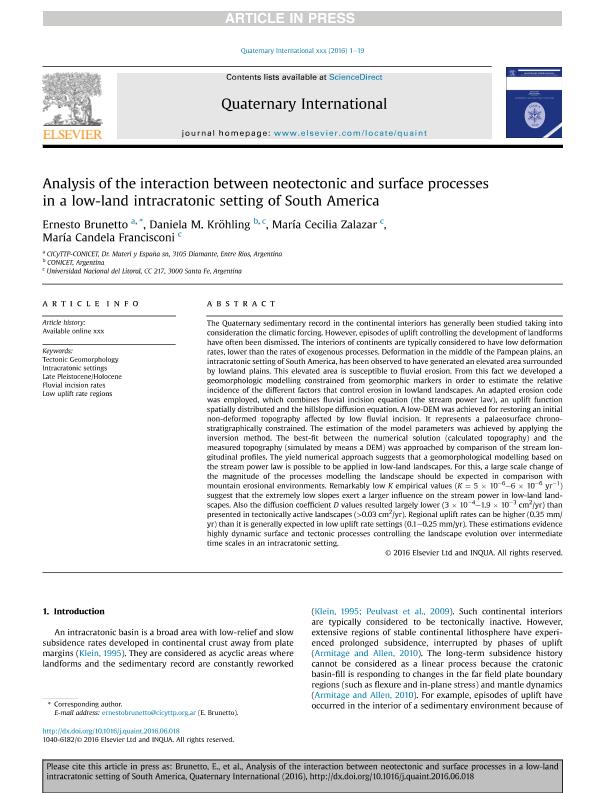Artículo
Analysis of the interaction between neotectonic and surface processes in a low-land intracratonic setting of South America
Brunetto, Ernesto ; Krohling, Daniela Mariel Ines
; Krohling, Daniela Mariel Ines ; Zalazar, María Carolina; Francisconi, María Candela
; Zalazar, María Carolina; Francisconi, María Candela
 ; Krohling, Daniela Mariel Ines
; Krohling, Daniela Mariel Ines ; Zalazar, María Carolina; Francisconi, María Candela
; Zalazar, María Carolina; Francisconi, María Candela
Fecha de publicación:
05/2017
Editorial:
Pergamon-Elsevier Science Ltd
Revista:
Quaternary International
ISSN:
1040-6182
Idioma:
Inglés
Tipo de recurso:
Artículo publicado
Clasificación temática:
Resumen
The Quaternary sedimentary record in the continental interiors has generally been studied taking into consideration the climatic forcing. However, episodes of uplift controlling the development of landforms have often been dismissed. The interiors of continents are typically considered to have low deformation rates, lower than the rates of exogenous processes. Deformation in the middle of the Pampean plains, an intracratonic setting of South America, has been observed to have generated an elevated area surrounded by lowland plains. This elevated area is susceptible to fluvial erosion. From this fact we developed a geomorphologic modelling constrained from geomorphic markers in order to estimate the relative incidence of the different factors that control erosion in lowland landscapes. An adapted erosion code was employed, which combines fluvial incision equation (the stream power law), an uplift function spatially distributed and the hillslope diffusion equation. A low-DEM was achieved for restoring an initial non-deformed topography affected by low fluvial incision. It represents a palaeosurface chrono-stratigraphically constrained. The estimation of the model parameters was achieved by applying the inversion method. The best-fit between the numerical solution (calculated topography) and the measured topography (simulated by means a DEM) was approached by comparison of the stream longitudinal profiles. The yield numerical approach suggests that a geomorphological modelling based on the stream power law is possible to be applied in low-land landscapes. For this, a large scale change of the magnitude of the processes modelling the landscape should be expected in comparison with mountain erosional environments. Remarkably low K empirical values (K = 5 × 10−6–6 × 10−6 yr−1) suggest that the extremely low slopes exert a larger influence on the stream power in low-land landscapes. Also the diffusion coefficient D values resulted largely lower (3 × 10−4–1.9 × 10−3 cm2/yr) than presented in tectonically active landscapes (>0.03 cm2/yr). Regional uplift rates can be higher (0.35 mm/yr) than it is generally expected in low uplift rate settings (0.1–0.25 mm/yr). These estimations evidence highly dynamic surface and tectonic processes controlling the landscape evolution over intermediate time scales in an intracratonic setting.
Archivos asociados
Licencia
Identificadores
Colecciones
Articulos(CCT - SANTA FE)
Articulos de CTRO.CIENTIFICO TECNOL.CONICET - SANTA FE
Articulos de CTRO.CIENTIFICO TECNOL.CONICET - SANTA FE
Citación
Brunetto, Ernesto; Krohling, Daniela Mariel Ines; Zalazar, María Carolina; Francisconi, María Candela; Analysis of the interaction between neotectonic and surface processes in a low-land intracratonic setting of South America; Pergamon-Elsevier Science Ltd; Quaternary International; 438; Part A; 5-2017; 141-159
Compartir
Altmétricas



